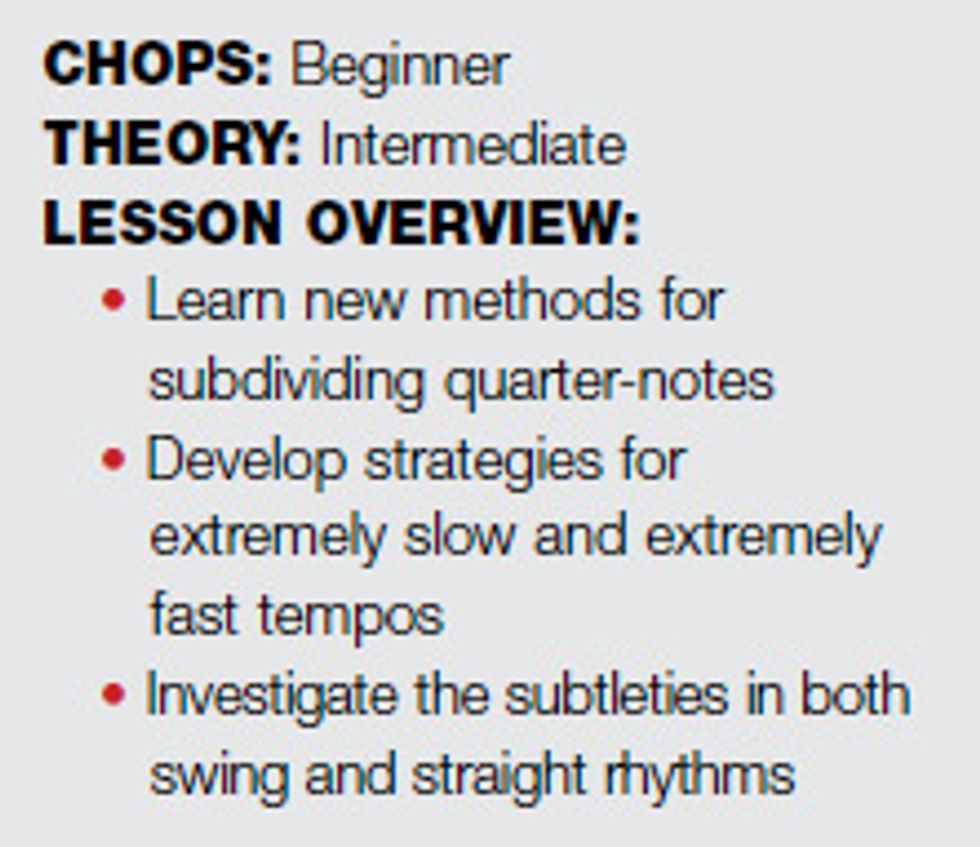As a bass player, I’m very interested in
rhythm—or more specifically, groove.
What’s the difference? I think of rhythm as
being generally how we describe the division
of measures and beats. Rhythm can be notated.
Groove, on the other hand, is rhythm
plus feeling. We all know it when we feel it.
There’s just no denying the emotional impact
of a band that’s “in the groove,” playing as
one. I think groove is distinctly human. It’s an
artistic reflection of our physical selves, how
we walk, dance, and breathe.
Much of what makes something groove has to do with how musicians find and agree upon a tempo, and how they subdivide the basic rhythmic unit of a tune (for example, the quarter-note). Within those subdivisions, there’s a lot of room for interpretation as to where to place notes and accents. The extent to which musicians play off of these subtle differences will determine whether something really grooves or not.
I think it all comes down to control. How much control do you have when it comes to note placement? Let’s look at a few examples of what I mean. Fig. 1 shows three typical ways you can divide a quarter-note. In the first measure, we split it up using sixteenth-notes. This example consists of a dotted-eighth-note on the downbeat, plus the last sixteenth-note of each beat. In the second measure, we move to a triplet feel and play the first and last note of each triplet. We move to straight eighth-notes in the final measure.
or download example audio

Now let’s try clapping out the three patterns in succession, repeating each bar a few times. Then—and here’s the tricky part—try to morph between the three patterns. Huh? Okay, let me explain: In this exercise the downbeat stays the same. Our goal is to slowly move the subdivision backwards (relative to the downbeats) from the sixteenth-note preceding the next downbeat, to the triplet and then all the way to the eighth-note. Listen to the audio example on the online version of this lesson to hear this shifting in practice.
You should do this accompanied by a metronome set to 80 bpm with the click being the downbeat. Try to get as smooth a transition as possible, imagining in your mind what the next subdivision in the series sounds like before you make your move.
Playing this pattern may seem counterintuitive. After all, isn’t groove about consistency and keeping things steady? That’s true, but in order to keep a steady beat you have to have a lot of control over where you place your notes. Strictly speaking, we’re keeping a steady pulse (the downbeat doesn’t move). It’s just the upbeat (subdivision) that we’re sliding around.
As I mentioned, there’s a lot of room for interpretation in how to feel subdivisions. I’m a jazz musician, so I swing a lot. The swing groove is based on dividing the quarter-note into triplets. Where you place the third triplet is really a matter of preference. The online version of this lesson has a few different triplet placements for you to hear. They’re all valid and all have a certain character, but are difficult to notate.
Of course, it’s equally important to be able to control your basic pulse or tempo. You might find that you’re better at keeping things steady in certain tempos. Medium tempos—with the quarter-note anywhere between, say, 80 and 160 bpm—are usually the most intuitive. (Is it a coincidence that this is the basic range of the human heartbeat?) But what happens to your sense of tempo at the extremes? Are you rock-steady at 40 bpm? What about 400 bpm?
One trick I’ve learned is to relate everything back to a manageable tempo by imagining subdivisions in your mind. For example, when you’re playing in a super-slow tempo like 40 bpm, you can think of the sextuplet-note subdivision shown in Fig. 2.
or download example audio

As an exercise, try playing along with this audio sample by creating a quarter-note melody over a blues in the key of F. Remember, you should only imagine the sextuplets in your mind as you play the quarter-notes. They’re mental placeholders. In the audio sample, I’ve faded them in and out so you can test if you’re in sync.
Conversely, if you’re playing at a very fast tempo, you can relate it back to a more manageable tempo by focusing on the downbeat of every other bar. In this case, the quarternote would actually feel more like a 32nd-note subdivision of a slow tempo. Psychologically, this helps me relax. Instead of stressing over every note, I’m focused on longer phrases.
Feeling subdivisions and hearing them in your mind (even when you’re not playing them) are vital skills. From my experience, working with a metronome is the surest way to hone them. I remember walking down the street many years ago and running into the great trumpeter Donald Byrd. I could hear a clicking noise coming from his pocket. He told me he liked to walk around with an electronic metronome on all day—to let a tempo really “sink in.” I’ve never forgotten that.
 Ben Allison
Ben Allison
Bassist/composer Ben Allison is one of a few bandleaders working in jazz today who has developed his own instantly identifiable sound. His last six albums—including his latest, Action-Refraction—have all reached the top of the CMJ jazz radio charts, and he has toured the world with The Ben Allison Band, Man Size Safe, Peace Pipe, and Medicine Wheel. Visit benallison.com for more information.
Much of what makes something groove has to do with how musicians find and agree upon a tempo, and how they subdivide the basic rhythmic unit of a tune (for example, the quarter-note). Within those subdivisions, there’s a lot of room for interpretation as to where to place notes and accents. The extent to which musicians play off of these subtle differences will determine whether something really grooves or not.
I think it all comes down to control. How much control do you have when it comes to note placement? Let’s look at a few examples of what I mean. Fig. 1 shows three typical ways you can divide a quarter-note. In the first measure, we split it up using sixteenth-notes. This example consists of a dotted-eighth-note on the downbeat, plus the last sixteenth-note of each beat. In the second measure, we move to a triplet feel and play the first and last note of each triplet. We move to straight eighth-notes in the final measure.
or download example audio

Now let’s try clapping out the three patterns in succession, repeating each bar a few times. Then—and here’s the tricky part—try to morph between the three patterns. Huh? Okay, let me explain: In this exercise the downbeat stays the same. Our goal is to slowly move the subdivision backwards (relative to the downbeats) from the sixteenth-note preceding the next downbeat, to the triplet and then all the way to the eighth-note. Listen to the audio example on the online version of this lesson to hear this shifting in practice.
You should do this accompanied by a metronome set to 80 bpm with the click being the downbeat. Try to get as smooth a transition as possible, imagining in your mind what the next subdivision in the series sounds like before you make your move.
Playing this pattern may seem counterintuitive. After all, isn’t groove about consistency and keeping things steady? That’s true, but in order to keep a steady beat you have to have a lot of control over where you place your notes. Strictly speaking, we’re keeping a steady pulse (the downbeat doesn’t move). It’s just the upbeat (subdivision) that we’re sliding around.
As I mentioned, there’s a lot of room for interpretation in how to feel subdivisions. I’m a jazz musician, so I swing a lot. The swing groove is based on dividing the quarter-note into triplets. Where you place the third triplet is really a matter of preference. The online version of this lesson has a few different triplet placements for you to hear. They’re all valid and all have a certain character, but are difficult to notate.
Of course, it’s equally important to be able to control your basic pulse or tempo. You might find that you’re better at keeping things steady in certain tempos. Medium tempos—with the quarter-note anywhere between, say, 80 and 160 bpm—are usually the most intuitive. (Is it a coincidence that this is the basic range of the human heartbeat?) But what happens to your sense of tempo at the extremes? Are you rock-steady at 40 bpm? What about 400 bpm?
One trick I’ve learned is to relate everything back to a manageable tempo by imagining subdivisions in your mind. For example, when you’re playing in a super-slow tempo like 40 bpm, you can think of the sextuplet-note subdivision shown in Fig. 2.
or download example audio

As an exercise, try playing along with this audio sample by creating a quarter-note melody over a blues in the key of F. Remember, you should only imagine the sextuplets in your mind as you play the quarter-notes. They’re mental placeholders. In the audio sample, I’ve faded them in and out so you can test if you’re in sync.
Conversely, if you’re playing at a very fast tempo, you can relate it back to a more manageable tempo by focusing on the downbeat of every other bar. In this case, the quarternote would actually feel more like a 32nd-note subdivision of a slow tempo. Psychologically, this helps me relax. Instead of stressing over every note, I’m focused on longer phrases.
Feeling subdivisions and hearing them in your mind (even when you’re not playing them) are vital skills. From my experience, working with a metronome is the surest way to hone them. I remember walking down the street many years ago and running into the great trumpeter Donald Byrd. I could hear a clicking noise coming from his pocket. He told me he liked to walk around with an electronic metronome on all day—to let a tempo really “sink in.” I’ve never forgotten that.
 Ben Allison
Ben AllisonBassist/composer Ben Allison is one of a few bandleaders working in jazz today who has developed his own instantly identifiable sound. His last six albums—including his latest, Action-Refraction—have all reached the top of the CMJ jazz radio charts, and he has toured the world with The Ben Allison Band, Man Size Safe, Peace Pipe, and Medicine Wheel. Visit benallison.com for more information.







![Rig Rundown: AFI [2025]](https://www.premierguitar.com/media-library/youtube.jpg?id=62064741&width=1245&height=700&quality=70&coordinates=0%2C0%2C0%2C0)












 Shop Scott's Rig
Shop Scott's Rig


![Rig Rundown: Russian Circles’ Mike Sullivan [2025]](https://www.premierguitar.com/media-library/youtube.jpg?id=62303631&width=1245&height=700&quality=70&coordinates=0%2C0%2C0%2C0)












































